Nov-12-12
 | | Chessical: Maroczy blunders with <36...Qd1>? which could have allowed Chigorin a winning advantage after: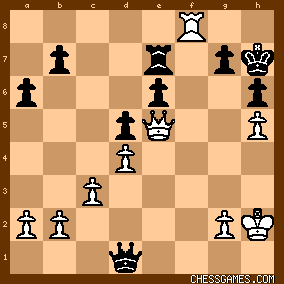
click for larger view<37. c4!> Qg4 (<37...dxc4?> 38. Qe4+ g6 39. Qxg6 mate) 38. cxd5 Qh4+ 39. Kg1 |
|
Jul-10-22
 | | KEG: Maroczy was sitting in first place when this game was played, while Tchigorin had four points out of eight (with one bye). These two were long-time rivals, and this was one of their bitterly contested encounters. Much of the game revolved around Maroczy's backward e-pawn. The Queen and Rook ending was almost certainly a theoretical draw, but nothing was ever easy when Tchigorin held even a small edge. Here, in a misguided effort to create counter-play, the usual solid Maroczy erred and gave Tchigorin a winning retort with his careless move 36. This had escaped notice for over a century, but it did not escape the always keen eye of [Chessical] who pointed out where and how Tchigorin could have won. After that, Tchigorin erred in the later Rook and Pawn ending giving Maroczy at least practical chances. All in all, the sort of hard-nosed battler we expect when such tough competitors square off. Over the course of their respective careers, Tchigorin and Maroczy played 17 times, with Maroczy winning 5 and Tchigorin 4 and the remaining 9 games. A fine rivalry 1. e4 d5?!
A surprise from the usually solid and stolid Maroczy. Bobby Fischer reportedly laughed when William Addison played this against him at the 1970 Interzonal. 2. exd5 Qxd5
3. Nc3 Qd8
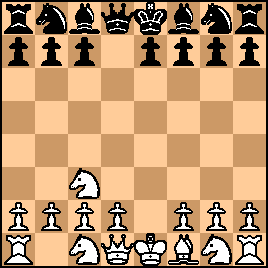
click for larger view3...Qa5 and 3...Qd6 are more common. But the text is sound and gives little away. Addison played this move in his above-cited Interzonal game against Fischer. This did not go well for Addison. 4. Nf3
4. d4 (Fischer's move against Addison) is more usual, but the text seems at least as good. The only downside is that in some lines in the Scandinavian the White Queen wants to come to f3 (as occurred in the Fischer--Addison game). 4... Nf6
5. d4 Bf5
6. Bc4 e6
7. 0-0 Be7
8. Qe2
A bit awkward. 8. Re1 is probably better. Alternatively, White can play8. Nh4 to bother the f5 Black Bishop. 8... 0-0
9. Be3 Nbd7
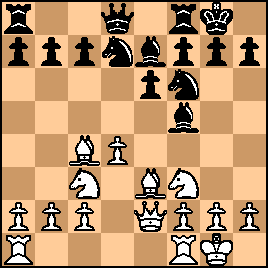
click for larger view10. Rad1
While there is nothing much wrong with the text, I am surprised that Tchigorin--a brilliant tactician and attacking played--by-passed 10. d5. Perhaps his choice was based on respect for Maroczy's defensive prowess. 10... Nc6
Solid. But 10...c6 was perhaps simpler and gives White even less to try to exploit than does the text. 11. Nb3 Nbd5
12. Ne5
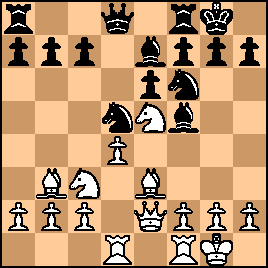
click for larger viewBoth sides to this point had played extremely sound chess, and chances were about even, with White holding at most a tiny edge. 12... c6
This gave Tchigorin some prospects. 12...NxN followed by 13...h6 gives Black an entirely safe position. The text gave Tchigorin a chance to start King-side operations immediately with 13. g4. 13. Bc1
But Tchigorin was still--uncharacteristically--playing it safe. After 13. Bc1, Maroczy could have eliminated the tension with 13...NxN. But Maroczy decided to maintain complexity. 13... Nd7
Effectively announcing that he didn't fear a King-side attack. A brave choice against the likes of Tchigorin. 14. f4
The critical line would begin with 14. g4. But Tchigorin apparently didn't want to take liberties against his formidable opponent. The position was now:
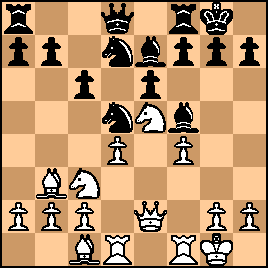
click for larger viewThus far, not a piece had been captured and only a pair of pawns had been traded. There had been a lot of shadow-boxing. But beginning here battle got joined, and some seemingly simplifying exchanges soon defined the contours of the struggle to come. |
|
Jul-10-22
 | | KEG: Post II
14... NxN (e5)

click for larger view15. NxN?
This could have lead to trouble. 15. fxN was correct and would lead to approximate equality. 15... cxN?
Maroczy could have avoided the pawn structure weakness he later faced and obtained the better game with 15...Nf3+! 16. fxN
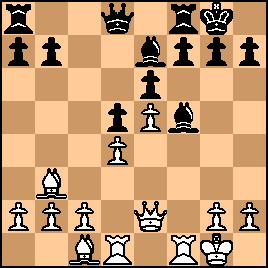
click for larger viewA level--and seemingly drawish--position has resulted. But neither Maroczy nor Tchigorin was ready to settle just yet for a draw.. 16... Bg5
16...Bg6 or 16...Be4 or probably even 16...Qd7 were simpler. But Maroczy had other ideas. 17. c3 BxB
18. RxB
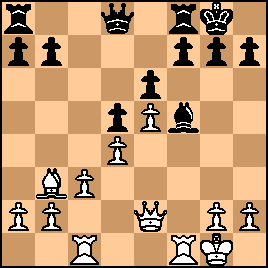
click for larger viewMaroczy was probably still just fine. But he still did not seem ready to take a draw (even with Black and despite a chance to score 0.75 points if he won the replay with White). 18... f6?!
Now the specter of a backward Black e-pawn began to loom. 18...Rc8 or 18...g6 were less problematic. 19. Rce1 Be4
Now Tchigorin decided to trade down to an ending in which Maroczy would have to contend with a weak e-pawn. 20. exf6 Rxf6
21. RxR QxR
22. Bc2 BxB
23. QxB Re8
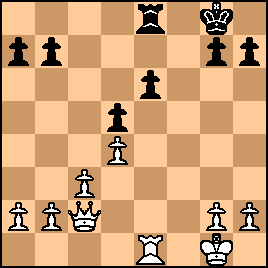
click for larger viewThis may be a theoretical draw, but the glaring hole on e5 meant that Maroczy would have to suffer for a while because of his backward e-pawn. "Tchigorin now stands better because of the backward pawn on e6..." (Tournament Book) The Tournament Book went on to state that Maroczy was "able to hold the draw" by "excellent defense." There ends the commentary on this game in the Tournament Book. A review of what transpired during the course of the next 50 moves of the game, however, shows that the above comment hardly tells the tale of this game. There was much excitement--and a few errors--to come, and Maroczy, and probably Tchigorin as well, came close to losing this heavy piece ending. 24. Qe2 a6
25. h3 h6
26. Qg4 Kh7
27. Rf1 Qe7
28. Qf4 Kg8
At this point, Maroczy was just sitting tight, awaiting Tchigorin's plan and also saving time as the move-30 time control approached. 29. Qe5 Qd7
30. Re1 Qc6
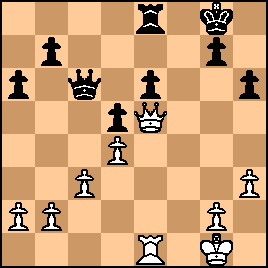
click for larger viewMove 30 had come, and now--as will be seen--the parties rolled up their sleeves the prepared to do battle, neither side seeming ready to agree to a draw. Indeed, the game still had 43 moves (often very eventful) moves to do. |
|
Jul-11-22
 | | KEG: Post III
31. Re3 Re7
32. h4
With the center and more specifically the e-pawn crisis at dead-lock, Tchigorin decided to try a King-side diversion. I'm not sure this should have amounted to anything, but it led Maroczy to attempt a demonstration of his own. 32... Kh7
33. h5
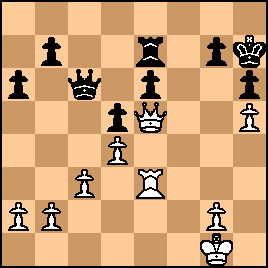
click for larger viewBlack seems to have everything defended, but beginning here Maroczy decided to pursue a plan that could have blown up in his face. 33... Qa4?!
On its face, there is nothing much wrong with this move, since the Black Queen can always be withdrawn in plenty of time. The problem was more with Maroczy's plan, as will be seen. 34. Kh2!
A clever move,insulating White from what could be annoying checks in some upcoming variations. The position was now: 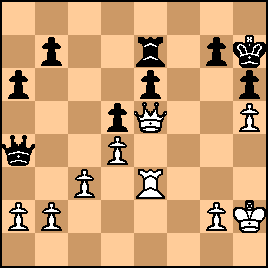
click for larger view34...Qxa2 35. Qd6, while not losing, gets Black nowhere. But Maroczy was not prepared to abandon his effort to muster an attack with his Queen, and so, instead of just repeating and seeking a draw with 34...Qd7 or 34...Qe8, Maroczy tried. 34... Qd1
This did not quite ruin anything, since Maroczy could counter anything aggressive from Tchigorin with Qxa5+ if the White Queen got frisky. But now Tchigorin played something that should have alerted Maroczy that he had to proceed with great care: 35. Rf3!
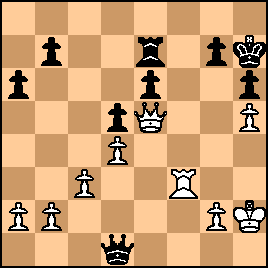
click for larger viewNow Black no longer has Qxh5+. But Maroczy, rashly, refused to back down: 35... Qd2?!
Maroczy should have played 35...b5 or 35...b5 or maybe 35...a5. The text, however, removed the White Queen from the d1..h5 diagonal and thus Qg4 was no longer available. Tchigorin immediately took full advantage of this new situation with: 36. Rf8!
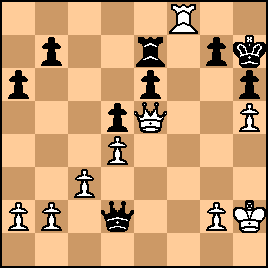
click for larger viewMaroczy could probably still have saved the day with 36...Qg5! But he apparently overlooked the danger and blundered with: 36... Qd1?

click for larger viewAlthough neither the players nor the Tournament Book noticed it, White now had a simple win, a fact that did not escape the careful scrutiny of <Chessical> on this site. The winning line line is given here by <Chessical> : 37. c4 Qg4 [even worse would be 37...dxc4 38. Qe4+ g6 39. Qxg6 checkmate] 38. cxd5 Qh4+ 39. Kg1 and Black is dead. BRAVO <Chessical> But Tchigorin missed this and instead played:
37. a3?
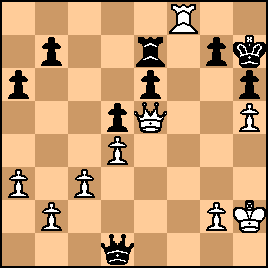
click for larger viewNow Maroczy had time to defend himself, and the win was gone: 37... Qg4
38. Rf4 Qg5
This left:
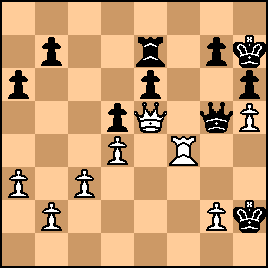
click for larger viewWas the game about to come to a quick and peaceful ending? Nope. In fact, the game still had 35 exciting moves to go. |
|
Jul-11-22
 | | KEG: Post IV
39. QxQ
39. Kh3 QxQ 40. dxQ looks like the only real chances for White to try for a win. The text seems to be an invitation to agree to a draw. But that's not how it worked it---at all. 39... hxQ

click for larger viewIf Tchigorin wanted to play for a win here, one would expect 40. Rf8. But Tchigorin had other (at least practical) ideas on how to proceed: 40. Rf2 g6
41. hxg6+ Kxg6
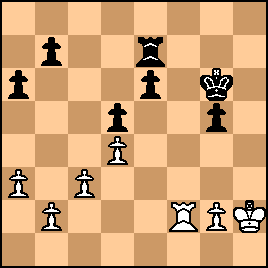
click for larger viewLooking more and more like a draw, right?
42. Kg3 e5
Anxious to get rid of his backward e-pawn.
Now, surely Tchigorin would play 43. dxe5 getting a tiny edge with no risk of losing. But no...
43. Re2 e4
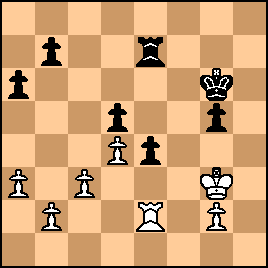
click for larger viewNow, out of nowhere, instead of a weak backward e-pawn, Maroczy had a protected passed e-pawn. Quite a difference! But in practice, despite this major change in the status of Maroczy's pawn structure, the game was still a clear draw. Right? 44. Kg4 b5
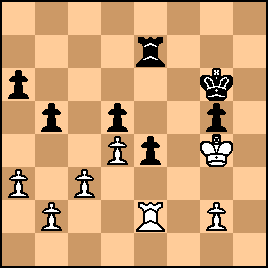
click for larger viewNow, if anything, the draws looks even more certain. But not for long: 45. b3?
With 45. g3 or 45. Kg3 (or just about any other quite move), the game is a draw. But the text weakened Tchigorin's Queen-side, and now things got dicey for Black. 45... Rf7
46. g3 Rc7
47. Rc2
Pretty much forced.
47... a5!
The best chance. Now Tchigorin would have to sweat to hold the draw: 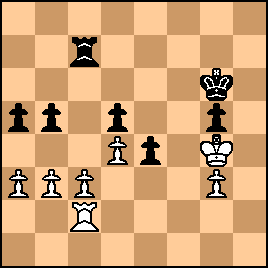
click for larger view48. Rc1!
Anything else would court disaster. If 48. b4 then 48...a4 would leave White at best a long hard fight to avoid loss. And if 48. a4, then 48...b4 49. c4 [forced] dxc4 50. bxc4 [forced] Kf6 would present White with a nightmarish ending to try to hold. By any reckoning, the text was best. It left:

click for larger viewThis is very likely a theoretical draw. But White still has a tough task before him. Beginning here, however, the game took some surprising twists and turns, and Tchigorin would flirt with catastrophe on several occasions before the game came to its conclusion 25 moves later. I should note that the above position might not be correct. A contemporary source disagreed with the game as given in the Tournament Book (and here) and reported 48. a4 as having been played. That source gives an entirely different follow-up. I have examined this alternative version of the game and found that it has so many moves I cannot believe came from Tchigorin and Maroczy that I have decided that analyzing this separate game score is a waste of time. I will therefore stick with the game score provided here and in the Tournament Book in any further posts on this game. |
|
Jul-11-22
 | | KEG: Post V
48... Rc8
Either this or 48...a4 were best.
49. a4?!
49. Rc2, waiting for Black to show his hand (probably with 49...a4) seems safest. But soft defense never appealed to Tchigorin. The text definitely opened a can or worms, but it is hard to imagine Tchigorin playing anything else. The position was now:
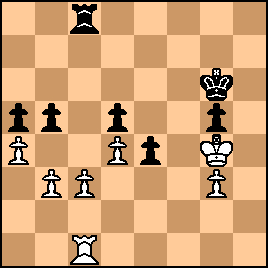
click for larger view49... bxa4
49...b4! definitely looks stronger, and would have caused Tchigorin to sweat: e.g., 50. c4 [forced] dxc4 51. bxc4 Re8 52. c5 Kf5 53. d5 Rc8 54. Rd1 Ke7 55. Kxg5 Rxc5 56. Kf4 Rc4 57. g4 e3+ 58. Kxe3 Rxg4 59. Rf1 Kd6 60. Kd3 Kc5 61. d6 Rd4+ 62. Kc2 Rxd6 63. Rf8 Kd4 and, though White may yet be able to save this pawn down Rook and pawn ending, he still has plenty of work to do. The text should have made Tchigorin's task easier. But nothing was ever easy with these guys. 50. bxa4 Kf6
51. Rb1
51. Rf1+ looks like an easier route to a draw.
51... Rxc3
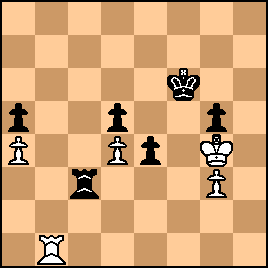
click for larger view52. Rb5 Ke6
53, Rxa5
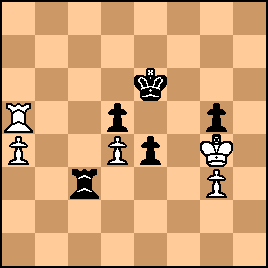
click for larger view53... Rd3
I'm far from sure there is any winning line for Black here. But 53...Rc4 seems to put White under more pressure. 54. Ra6+ Kd7
55. Kxg5
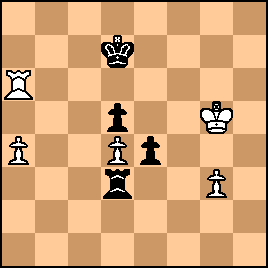
click for larger view55... Rxd4?
This should have made Tchigorin's task easy. 55...Rxg3+ was surely a better practical try. 56. Kf4
Forced.
56... Rd3
If this is what Maroczy had in mind with his 55th move, he had clearly miscalculated. White now has a seemingly easy draw, the position now being: 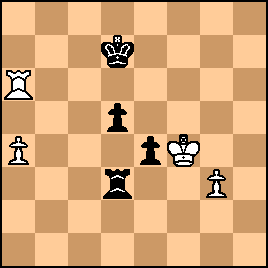
click for larger view57. Rb6 or 57. a5 solve Black's problems and the game should soon thereafter end in a draw. But Tchigorin was still playing for a win, and--as will be seen--was prepared to take all sorts of wild chances, and risk defeat in his quest for victory. What Tchigorin now did can hardly be called sound, but it shows just how frightening it must have been to sit down across the chess board and face this bundle of aggressive ideas. |
|
Jul-12-22
 | | KEG: Post VI
What I meant to say in my last post was that 57. Rb6 or 57. a5 solve WHITE'S problems. But Tchigorin instead played: 57. g4?
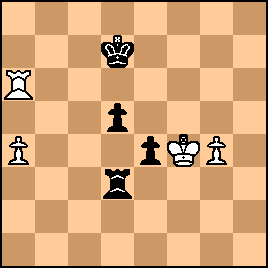
click for larger viewNow Maroczy had the time to push his pawns---and win. But with Tchigorin there was always not-stop pressure, and even the technically sound hard-to-ruffle Maroczy became sufficiently transfixed to miss his clear winning chances. Maroczy did, however, start off just fine:
57... e3!
58. Ra7+ Kd6
59. Ra6+ Kd7
Maroczy, as will be seen, knew full well that 59...Kc5 was the way to win. But with the move-60 time control approaching, he decided to gain some time on the clock. 60. Ra7+ Kd6
61. Ra6+
Back where we were two moves ago, but this time Maroczy was ready to pounce. 61... Kc5!
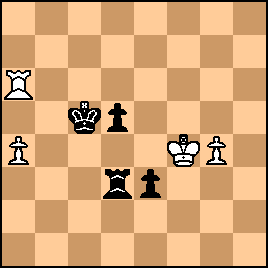
click for larger view62. g5
His only counter-chance, but one that should nothave worked. 62... d4!

click for larger view63. Re6
Whether Tchigorin played this or 63. g6 first made no difference. 63... Rd1
64. g6
Tchigorin now had no choice.
64... Rf1+
65. Kg5
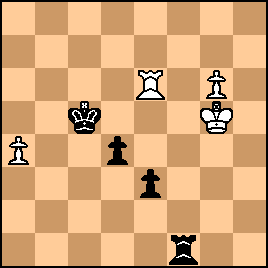
click for larger view65... Rf8?
This one slip cost Maroczy the game, which could have been won via 65...Re1; e.g., 66. g7 e2 67. Re5+ [67. g8(Q) would lose even faster; 67...Rg1+ 68. Kf6 RxQ 69. Rxe2 d3 70. Rd2 Kc4] Kb4 68. Re4 Kg3 69. Rg4 Rf1 70. g8(Q) e1(Q) 71. Qc8+ Kb2 72. Qb7+ Kc1 73. Qc6+ Qc3 74. Qd5 Qe3+75. Qh5 Qe8+ 76. Rg6 d3 77. a5 [77. Qxd3 Qe5+ 78. Rg5 Rh1+ 79. Kg6 Qe6+80. Kg7 Qe7+ 81. Kg8 (not 81. Kg6 Qh7+ winning the White Queen) QxR+ and wins] Qf7 78. QxQ RxQ 79. Rc6+ Kb2 80. Rb6+ Kc2 81. Rc6+ Kb3 82. Rb6+ Kc3 83. Rc6+ Kd4 84. Rd6+ Ke3 85. Re6+ Kf2 86. Rd6 Ke2 Kd1 87. a6 Rd7 88. Kg4 d2 89. Kf5 Kc1 90. Rc6+ Kb1 91. Rb6+ Kc2 92. Rc6+ Kd3 and wins (this variation, despite its length, is not that difficult to handle over the board, especially for a technician such as Maroczy. After 65...Rf8?, Tchigorin was after to escape neatly, the position now being: 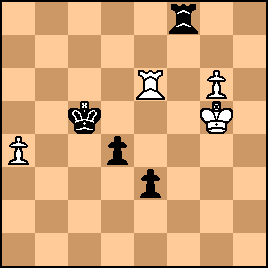
click for larger view66. g5
66. a5 also draws.
66... Rd8
Or 66...Rg8
67. Re7 d3

click for larger viewAt first sight, this looks like Black must win, and perhaps Maroczy missed Tchigorin's brilliant saving resource. White to move and draw. |
|
Jul-12-22
 | | nizmo11: Excellent analysis, two small comments:
<55...Rxg3+ was surely a better practical try.>
I wanted to disagree until I saw the beautiful trap:
56. Kf4 Rf3+ 57. Ke5? would lose to 57...e3 58.Kxd5 Rf5+! 59.Kc4, White seems to be out of trouble, but:

click for larger view
59...Re5!! and the pawn promotes, resulting to a tablebase win.
<to move 56...Re1>[!!]: extremely strong move, but a small correction to the long variant
71...Kb2? (72.Kd2) would be a mistake because of 72.Qb8!+ Kc1 (72...Kc2?? 73. Qh2+!) 73.Qf4+ and White draws. |
|
Jul-12-22
 | | KEG: <Nizmo11> Thank you for your comments and especially for your analysis of the line after 55...Rxg3+. But I disagree about your claim that 71...Kb1 (in one of my extended lines) would have been a mistake. If then 72. Qb8+ as you suggest, Black wins with 72...Kc1 [72...Kc2 would be a mistake as you say, but only with 73. Rg2+ and not with 73. Qh2+ after which Black wins with 73...Kc1 and if then 74. Qc7+ Qc3 and White is done for] since if 73. Qc8+ then 73...Qc3. Your 73. Qf4+ loses to 73...RxQ. Unless I have missed something very obvious. |
|
Jul-12-22
 | | nizmo11: I had a wrong position... You analyze
<68. Re4 Kg3 (sic) 69. Rg4> [the best practical chance, rooks remain on the board] 69...Rf1! (looks like the only winning move).
While I played 69.g8D Rg1+ 69 Rg4 e1D!?
(69...Rxg4+ with a tb win )
71.Qc8+ and now Kd2 would win but not 71...Kb2 Qb8!+ |
|
Jul-12-22
 | | KEG: <nizmo11> We must still have different positions. [Plus I had a typo in my response..I meant to type "71...Kb2" not 71...Kb1"]. In any case, back to your analysis:
After 71. Qc8+ Kb2 is the only winning move. If 71....Kd2? then White wins with 72. Rxd4+. But after 71...Kb2 72. Qb7+ Kc1 Black wins: e.g., 73. Qc6+ Qc3 74. Qd5 Qe3+ 75. Kh5 Qe8+ 76. Rg6 d3 77. a5 Qe2+ 78. Kh6 Qh2+ 79. Kg7 Qc7+ 80. Kg8 Qf4 81. Qc5+ Kd2 82. Kh7 [Black was threatening 82...Qf7+ and 83...Rh1+] 82. Qe7 Qc4+ 83. Qe6 (the only chance) Rc1! 84. a6 (or 84. QxQ RxQ 85. a6 Kc2 86. Kh8 [or 86. a7 Rc8+ 87. Kh7 Ra8 88. Rc6+ Kb1 and Black wins) d2 87. a7 d1(Q) 88. Rg2+ Kc1 89. a8(Q) Qh1+ 90. Kg8 Rg4+ and wins) Qc8+ 85. QxQ RxQ+ 86. Kh7 Ke2 87. Rg8 d2! 88. RxR d1(Q) and wins. |
|
Jul-12-22
 | | KEG: Post VII
Returning to the position after 67...d3:

click for larger viewThe one and only saving move is:
68. Rd7!!
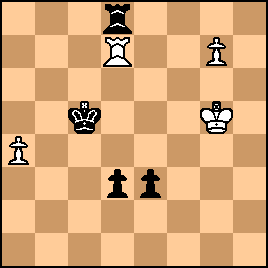
click for larger viewPretty and ingenious!!
68... Re8
The toughest line for White to face. If 68...Rg8 69. Rxd3 Rxg7+ 70. Kf4 [forced] e2 71. Re3 and draws. If instead 68...RxR then the exciting conclusion might be (there are many alternative lines) 69. g8(Q) Rd5+ 70. Kf4 e2 71. Qe6 Rd4+ 72. Kg5 Rxa4 73. Qf5+ Kb4 74. Qf4+ Kc3 75. QxR d2 76. Qa1+ and draws by perpetual check. 69. Rxd3 e2

click for larger view70. Rc3+
Forced.
70... Kb4
71. Rc1 e1(Q)
72. RxQ RxR
73. Kf6

click for larger viewAnd here the players agreed to the obvious draw. Quite an exciting finale! |
|
|
|
|





